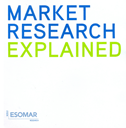The basics
- Market research – what it is ... what it’s not
- Market research: why bother?
- Life is random
- Knowledge matters: a lot, actually
- A new discipline is born
- ... but how far can it go?
In practice
- Market research – the industry
- Professional standards
- Market researchers – new capabilities
- Working with agencies
- Preparing a brief
- Getting started
Starting to find information
- Desk research
- Syndicated research
- Ad hoc surveys: qualitative or quantitative?
Quantitative research
- Quantitative research
- Surveys: personal interviews
- Surveys: telephone interviews
- Surveys: postal
- Surveys: online
- Surveys: observational
Qualitative research
- Qualitative research
- In depth interviews
- Focus groups
- Projective techniques
- Other qualitative techniques
Tools and techniques
- Questionnaires
- Sampling
- Interviewer skills
Results
- Data: managing and analysis
- Data: reporting
- Understanding the jargon
- References

